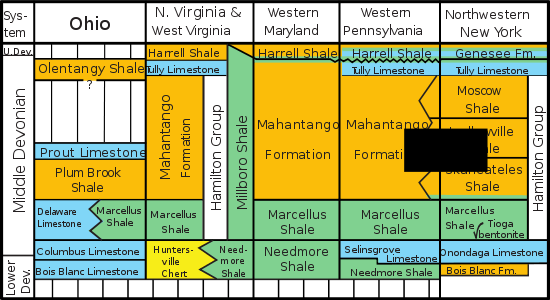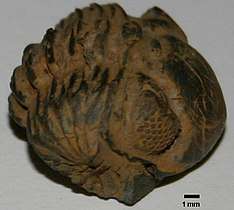Mahantango Formation
The Devonian Mahantango Formation is a mapped bedrock unit in Pennsylvania, West Virginia, and Maryland[1][2][3]. It is named for the North branch of the Mahantango Creek in Perry and Juniata counties in Pennsylvania. It is a member of the Hamilton Group, along with the underlying the Marcellus Formation Shale.[4] South of Tuscarora Mountain in south central Pennsylvania, the lower members of this unit were also mapped as the Montebello Formation.[5] Details of the type section and of stratigraphic nomenclature for this unit as used by the U.S. Geological Survey are available on-line at the National Geologic Map Database.[6]
| Mahantango Formation Stratigraphic range: Givetian, ~387 Ma | |
|---|---|
 Outcrop of the Mahantango on Rt. 522, Fulton County, Pennsylvania | |
| Type | Geological formation |
| Unit of | Hamilton Group |
| Sub-units | See: Description |
| Underlies | Harrell Shale and West Falls Formation |
| Overlies | Marcellus Formation |
| Lithology | |
| Primary | Shale |
| Other | Limestone, Siltstone |
| Location | |
| Region | Appalachian Basin of eastern North America |
| Extent | Maryland, New Jersey, New York, Ohio, Pennsylvania, Virginia, and West Virginia |
| Type section | |
| Named for | Mahantango Creek |
Description
The Mahantango Formation is a gray, brown, and olive siltstone and shale,[7][8] characterized by coarsening-upward cycles.[4]
Stratigraphic Setting

The Mahantango Formation is typically found conformally overlying the Marcellus Formation, and underlying the Tully Limestone (where present).[9]
The Mahantango has been divided into four members:[10]
- Tully Limestone: a fossiliferous calcaerous shale. The Tully is a conspicuous formation, which separates the Mahantango from the Hamilton Group.[9]
- Sherman Ridge: Olive gray, fossiliferous, claystone and siltstone with interbedded fine sandstone coarsening upward.
- Montebello Sandstone: Olive gray, fossiliferous, coarse to fine-grained sandstone, interbedded with siltstone and claystone, in coarsening upward cycles.
- Fisher Ridge (also described as the Dalmatia and Turkey Ridge): silty claystone, siltstone, and very fine-grained sandstone.
The Sherman Ridge and Fisher Ridge are ridge-formers.[11]
In south-central Pennsylvania, the Mahantango includes the Clearville, Frame, Chaneysville, and Gander Run Members.
Fossils

There are numerous marine fossils found in the Mahantango including Brachiopods, Crinoids, Trilobites, Bivalves, and Bryozoans.
Brachiopods
- Athyris
- Chonetes
- Mucrospirifer
- Protoleptostrophia
- Tropidoleptus
Crinoids
Trilobites
- Basidechenella
- Dipleura
- Eldredgeops (formerly Phacops)
- Greenops
Bivalves
- Grammysioidea
- Grammysia
- Leiopteria
- Modiomorpha
- Orthonota
Bryozoa
Coral
- Pleurodictyum
- Trachypora
Gastropods
- Bembexia
- Crenistriella
- Cyclonema
- Glyptotomaria
- Loxonema
- Platyceras
Cephalopods
- Tornoceras
- Agoniatites
- Spyroceras
- Michelinoceras
- Bactrites
Age
Relative age dating of the Mahantango places it in the Middle Devonian period, being deposited between 392 and 385 (±3) million years ago. It rests conformably atop the Marcellus Formation shale. Its upper contact is also conformable to the Trimmers Rock Formation and Harrell Shale.[12] In 2012, Read and Erikson reported the formation as Givetian in Virginia.[13]
Interpretation of Depositional Environments
The Mahantango represents a terrestrial to marine transition zone that went through many transgressive-regression sequences. The fine-grained rocks represent a shallow sea environment and accounts for many of the fossils. Coarser grained sediments represent near-shore environments, beaches, or possibly delta lobes. These environments were tide-dominated and often had violent storms. The Montebello Sandstone member is an example of a storm dominated rock unit. Brachiopod fossils are scattered in massive sandstone beds throughout the rock unit, while the Sherman Ridge member is more laminated with fossilized ripple marks often indicating tidal current directions.[14]
Economic Resources
See also
References
- Ryder, R.T., Swezey, C.S., Crangle, R.D., Jr., and Trippi, M.T., 2008, Geologic cross section E-E’ through the central Appalachian Basin from the Findlay Arch, Wood County, Ohio, to the Valley and Ridge Province, Pendleton County, West Virginia: U.S. Geological Survey Scientific Investigations Map SIM-2985, 2 sheets with 48-page pamphlet. https://pubs.er.usgs.gov/publication/sim2985
- Ryder, R.T., Crangle, R.D., Jr., Trippi, M.H., Swezey, C.S., Lentz, E.E., Rowan, E.L., and Hope, R.S., 2009, Geologic cross section D-D’ through the central Appalachian basin from the Findlay arch, Sandusky County, Ohio, to the Valley and Ridge province, Hardy County, West Virginia: U.S. Geological Survey Scientific Investigations Map SIM-3067, 2 sheets with 52-page pamphlet. https://pubs.er.usgs.gov/publication/sim3067
- Ryder, R.T., Trippi, M.H., Swezey, C.S., Crangle, R.D., Jr., Hope, R.S., Rowan, E.L., and Lentz, E.E., 2012, Geologic cross section C-C’ through the central Appalachian basin from near the Findlay Arch, north-central Ohio, to the Valley and Ridge Province, Bedford County, south-central Pennsylvania: U.S. Geological Survey Scientific Investigations Map SIM-3172, 2 sheets with 70-page pamphlet. https://pubs.er.usgs.gov/publication/sim3172
- "Explanation of Geologic Units" (PDF). Pennsylvania Geological Survey. Retrieved 2008-01-26.
- Conlin, Richard R.; Hoskins, Donald M. Geologic Map of the Mifflintown Qd (Map). 1:24,000. Cartography by United States Geological Survey. Pennsylvania Geological Survey, Fourth Series. A126.
- https://ngmdb.usgs.gov/Geolex/Units/Mahantango_2597.html
- Berg, T.M., Edmunds, W.E., Geyer, A.R. and others, compilers, (1980). Geologic Map of Pennsylvania: Pennsylvania Geologic Survey, Map 1, scale 1:250,000.
- Milici, R.C., and Swezey, C.S., 2014, Assessment of Appalachian Basin oil and gas resources: Devonian gas shales of the Devonian Shale-Middle and Upper Paleozoic Total Petroleum System, in Ruppert, L.F., and Ryder, R.T., eds., Coal and Petroleum Resources in the Appalachian Basin: Distribution, Geologic Framework, and Geochemical Character: U.S. Geological Survey Professional Paper 1708, chapter G.9, 81p. http://pubs.usgs.gov/pp/1708/g9/pdf/pp1708_g9.pdf
- Milici, Robert C.; Swezey, Christopher S. (2006). "Assessment of Appalachian Basin Oil and Gas Resources: Devonian Shale–Middle and Upper Paleozoic Total Petroleum System" (PDF). United States Geological Survey. Retrieved 2008-04-05.
- MacLachlan, D.B., Hoskins, D.M., Payne, D.F., (1995). Bedrock Geology of the Freeburg 7.5 minuet Quadrangle, Snyder County, Pennsylvania. ORF 95-04, The Pennsylvania Geologic Survey, Harrisburg, PA.
- "Paleozoic Stratigraphic Column of Central Pennsylvania" (pdf). Bucknell University. Retrieved 2008-05-26.
- Berg, T.M., et al., (1983). Stratigraphic Correlation Chart of Pennsylvania: G75, Pennsylvania Geologic Survey, Harrisburg, Pennsylvania.
- Paleozoic Sedimentary Successions of the Virginia Valley & Ridge and Plateau
- Prave, A.R., Duke, W.L., Slattery, W. (1996). A depositional model for storm- and tide-dominated prograding siliciclastic shorelines from the Middle Devonian of the central Appalachian foreland basin, USA. Sedimentology, 43, 611-629.
External links
| Wikimedia Commons has media related to Mahantango Formation. |